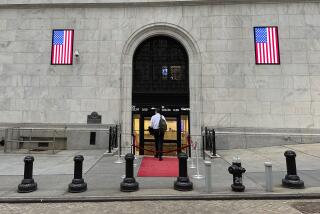High-Tech Crisis Forces Publishers to Make Tough Choices : Shortage of Memory Chips Hurting Video Game Makers
- Share via
Nintendo of America has thinned out its video game library, dumping a popular version of Donkey Kong. Sega of America has delayed introduction of some new video games and is concerned about hitting its Christmas season sales target. And other makers of toys and yuppie playthings are standing by, nervously watching a seemingly unlikely barometer: the availability of key computer memory chips.
Like their high-tech brethren in the computer business before them, video game publishers are getting hit by a shortage of chips, the tiny bits of silicon and wire that let electronic gizmos store everything from personnel reports to Pac Man.
For video game makers, the critical shortage is of SRAMs, or static random access memory chips. Computer makers are suffering from an acute shortage of DRAMs, or dynamic random access memory chips. The two chips are similar, but SRAMs work more quickly and are less expensive.
The shortage of DRAMs, which began a year or so ago, is by far the more acute. But analysts and game makers say the crisis has started to spill over into the SRAM market.
Analysts at Dataquest, a high-tech market researcher, say they first noticed the shortage last month. They attribute the SRAM shortage to decisions by Japanese chip makers, which manufacture the majority of the world’s supply, to concentrate their efforts on DRAMs, a large and fast-growing market the Japanese also dominate.
“It’s a question of resource allocation,” said Dataquest analyst Michael Boss. “The Japanese companies are going where the money is, and that’s in DRAMs now.”
Nintendo confirmed Wednesday that it has stopped making 12 older games in part to free scarce chips for new games. The company said it also postponed the introduction of Link, a sequel to its best-selling Legend of Zelda video game, from February to October.
The result, Nintendo executives said, is that some video game players will have to do without.
“I think when the year ends, (video game) supply will be 10% to 15% less than what real market demand is,” said Peter T. Main, Nintendo’s marketing vice president.
A competitor, Sega of America, said it isn’t feeling the effects of the shortage as greatly because it relies more heavily on different memory chips. Still, the SRAM chip shortage is forcing Sega to delay introduction of some new video games until next year, said David Rhodes, marketing vice president.
Adjusting to chip shortages is nothing new for computer makers. Over recent months, the DRAM shortage has become quite acute, prompting price hikes for computers and a variety of problems.
The market forces creating the shortage began to take shape last autumn, said Stan Victor, a spokesman for Texas Industries, one of the only two U.S. producers of the memory chips. At that time, many of the world’s producers began to prepare for a new generation of semiconductors and retooled some of their plants to make the one-megabit chip, which has four times the capacity of the previous standard.
The shortfall was created when producers split their production capacity to meet the demand for two chip markets, said Victor. “The market is going to be a bit tight until the one-megabit supply catches up with demand and that won’t be until the fourth quarter (of 1988) or the first quarter of next year,” Victor said.
Consequently, Hewlett-Packard has indefinitely delayed the rollout of a new personal computer. Apple Computer is rumored to have temporarily shelved plans for a new version of its popular Macintosh model. Sun Microsystems and AST Research have raised prices for their popular desktop computers. And Kaypro, a struggling personal computer maker, said it has already laid off 38 employees and faces the prospect of letting go as many as 100 more as a result of the chip shortage.
Although computer makers typically have supply agreements with chip makers, the industry’s strong sales over the last 18 months have increased the need for chips beyond contract levels. As a result, computer manufacturers are forced to look to secondary suppliers--and even to the spot market--for the chips they need.
Analysts say spot prices for DRAMs capable of storing 256,000 bits of information, the current standard, have risen from $2 each in early 1987 to as much as $10 to $12 in some areas. A typical personal computer, such as a system equivalent to the IBM-AT, needs 16 such DRAM chips. A more powerful computer, such as IBM’s System 30 model, requires 32 such chips.
The outlook is bleak through the remainder of 1988. Analysts and manufacturers say they are prepared for demand, which has been running at least 20% above supply for the last nine months, to remain unsatisfied until early next year--at the earliest.
Gordon Campbell, president of Chips & Technologies in San Jose, said that “until now, the parts have been available if you were willing to pay the price.” But now, he said, he is hearing “rumblings” that large manufacturers would be forced to curtail production during the third quarter. Chips & Technologies makes custom sets of chips for the PC industry.
In fact, Compaq Computer confirmed Wednesday that it expects its fast-paced growth to slow this year, in part because of the chip shortage.
Apple Computer in Cupertino has increased the prices of the kits that add memory to its PCs and laser printers. Because soaring demand for the kits was forcing the company to buy chips at higher prices, two weeks ago Apple raised its prices. A 2-megabyte memory upgrade kit increased from $599 to $849.
Apple said sales of its computers have been unaffected by the chip shortage due to its relationships with its suppliers. But the company has repeatedly declined to comment on the rumored shelving of its new product.
Last week, citing “the industry-wide memory problem,” Sun Microsystems of Mountain View slapped a 50% surcharge on add-on memory for its popular models. The price for additional memory for the Sun workstations was raised from $500 to $750 per megabyte.
Sun spokesman John Loiacono said the chip shortage has also resulted in long delays in shipping the company’s products. “For our 3/60 line, the lead time is 120 to 150 days, compared to a typical lead time of 45 to 60 days,” he said.
Worse, said Loiacono, “there is no end in sight . . . there is no improvement visible in the foreseeable future.” Sun President Scott McNealy recently said the chip shortage would hurt sales in the fiscal year ended June 30 by 15% to 20%.
A spokesman for Hewlett-Packard of Palo Alto said the chip shortage forced it to postpone the planned announcement of its new Vectra QS personal computer at an important trade show last month.
Times staff writers Denise Gellene, Victor Zonana and George White contributed to this story.






